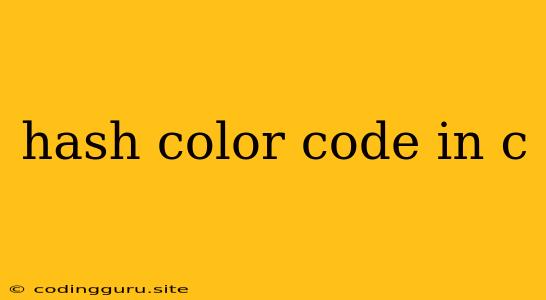Hash Color Code in C: A Comprehensive Guide
Have you ever wondered how websites and applications display vibrant colors? The answer lies in hash color codes, a standardized system for representing colors digitally. In this guide, we'll delve into the world of hash color codes within the C programming language, exploring their structure, usage, and practical applications.
What are Hash Color Codes?
Hash color codes are a hexadecimal representation of colors in the RGB (Red, Green, Blue) color model. They are commonly used in web development, graphics design, and various programming languages, including C.
The Structure of a Hash Color Code
A hash color code follows a specific format: #RRGGBB. Let's break down each component:
- #: The '#' symbol precedes the color code, serving as a marker for the code.
- RR: Represents the red color component, ranging from 00 to FF (hexadecimal values).
- GG: Represents the green color component, also ranging from 00 to FF.
- BB: Represents the blue color component, again ranging from 00 to FF.
Understanding Hexadecimal Values
Hexadecimal (base-16) numbers use digits 0-9 and letters A-F to represent values. In hash color codes, each pair of hexadecimal digits (RR, GG, BB) represents the intensity of the respective color component.
- 00: Represents the minimum intensity (0% of the color).
- FF: Represents the maximum intensity (100% of the color).
Using Hash Color Codes in C
To utilize hash color codes in C, you can use the #define directive to assign them to specific color variables. Here's an example:
#define RED "#FF0000" // Red color
#define GREEN "#00FF00" // Green color
#define BLUE "#0000FF" // Blue color
These #define statements allow you to use the defined names (RED, GREEN, BLUE) directly in your C code when working with colors.
Converting Decimal to Hexadecimal
You may need to convert decimal values to hexadecimal for hash color code creation. C provides functions to achieve this.
int decimalValue = 255; // Decimal value
char hexValue[3];
sprintf(hexValue, "%02X", decimalValue); // Convert to hexadecimal
This code snippet converts the decimal value 255 to its hexadecimal equivalent, FF. You can use this principle to create hash color codes from your desired color components.
Creating Custom Hash Color Codes
You can create custom hash color codes based on your preferred color combinations. For example:
#define MY_CUSTOM_COLOR "#789ABC" // A custom color code
This defines a new color, MY_CUSTOM_COLOR, with a unique combination of red, green, and blue components.
Practical Applications of Hash Color Codes in C
Hash color codes are valuable in C programs for various purposes:
- Graphics and Visualization: They can be used to define colors for shapes, lines, and text in graphics libraries.
- User Interface Design: Hash color codes contribute to creating visually appealing user interfaces, enhancing readability and aesthetics.
- Data Visualization: When working with charts, graphs, and data visualizations, hash color codes help to differentiate data points effectively.
- Web Development (CGI): C programs interacting with web interfaces can use hash color codes to dynamically generate HTML pages with specific colors.
Tips for Using Hash Color Codes in C
- Consistency: Maintain a consistent format for your hash color codes throughout your project to ensure clarity and maintainability.
- Color Tools: Utilize online color pickers or tools to generate hash color codes for your desired colors.
- Color Palette: Consider using color palettes to achieve harmonious visual combinations within your applications.
- Accessibility: Be mindful of color contrast and ensure your color choices provide accessibility for users with visual impairments.
Conclusion
Hash color codes are essential for working with colors in the C programming language. They offer a standardized way to represent colors digitally, enabling you to create visually appealing and functional applications. By understanding the structure and usage of hash color codes, you can effectively incorporate them into your C projects for graphics, user interface design, and data visualization.
